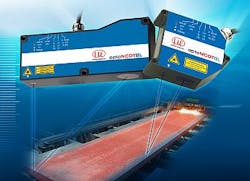Blue-laser triangulation sensor measures hot metals
Engineers faced with the need to develop systems that measure the position or displacement of red-hot glowing metals can now take advantage oftriangulation sensors that employ blue lasers.
The devices, recently introduced byMicro-Epsilon (Raleigh, NC, USA), offer some technical advantages over previous red-laser-based triangulation devices.
While conventional red-laser-based sensors encounter a high signal interference from the surface of red-hot glowing metals -- because such surfaces emit the same or very near wavelengths of light as the red laser -- blue-laser-based devices work at a wavelength of 405 nm, which is far from the red part of the visible spectrum. As such, interference from the target is significantly less.
A laser diode in the device projects light onto the surface of a target, and the light reflected it is then captured by aCCD imager. If the target changes position with respect to the sensor, the light projected on the CCD can be analyzed to determine the exact position of the target. The measurements are then processed digitally in an integral controller and the data is output though an analog or digital interface.
As well as making position or displacement measurements on hot, glowing metals -- particularly in hot steel processing applications -- the new blue laser devices could also prove useful for measuring organic materials such as skin,foods, plastics, veneers and wood.
-- Posted byVision Systems Design
